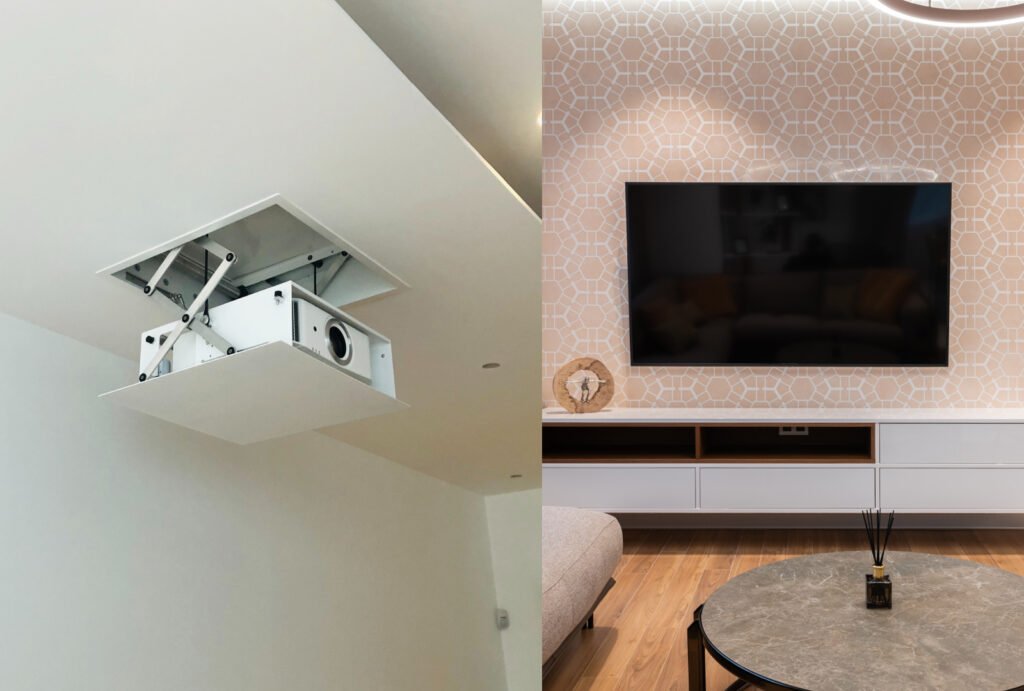When it comes to enjoying movies, TV shows, or gaming in the comfort of your own home, two primary options come to mind—the trusty television and the versatile projector. Both have their own unique features and advantages. This makes the decision between the two a matter of personal preference and specific needs. Let’s dive into a comparison between televisions and projectors to help you make an informed choice for your home entertainment setup.
Display Quality
Televisions have come a long way in terms of display quality. With advancements in technology, you can find TVs with stunning 4K Ultra HD resolution, HDR (High Dynamic Range) capabilities, and excellent colour reproduction. The images are sharp, vibrant, and offer exceptional detail, making it a great choice for those who prioritize visual fidelity.
Projectors, on the other hand, offer the unique advantage of creating a large-scale cinematic experience. While they might not match the pixel-perfect clarity of high-end televisions, projectors excel at producing massive images that can span the entire wall. The immersive experience of a projector, combined with HD or 4K resolution options, can make you feel like you’re in a movie theater, especially in a darkened room.
Screen Size and Flexibility
TVs generally come in a fixed screen size, ranging from small to extra-large sizes. While larger TVs can provide an immersive experience, they require a dedicated space and can dominate a room. If you have limited space, a TV might not be the most practical option.
Projectors offer unparalleled flexibility when it comes to screen size. They can easily project images onto any suitable flat surface, allowing you to adjust the screen size according to your preferences. From compact projections to massive displays, projectors can adapt to any room size. This versatility makes them a fantastic choice for smaller spaces or for those who enjoy hosting movie nights and gatherings.
Installation and Portability
Television set up is relatively straightforward. You mount it on a wall, place it on a stand, or even use a TV cabinet. The installation process is typically hassle-free, and once set up, it requires minimal adjustments. However, TVs are less portable and can be challenging to move or reposition once they are in place.
Projector installation requires a bit more effort. It involves using a projector stand or mounting the projector on the ceiling, almost quite literally. Recently, I came across this novelty that the projector is built into your ceiling light! If you hate this hassle of installation, you can consider the option of the ultra-short throw projectors that you can simply place it right on your console top , like this one from Xiaomi which can even give you up to a screen size of 150”! Projectors nowadays have also become highly portable, allowing you to easily move them from room to room or even take them outdoors for a movie under the stars. This portability offers a level of versatility that televisions can’t match. It’s crazy that they are becoming smaller and smaller like Lumos and Xgimi.
Lighting Conditions
TVs perform well in any lighting condition. They usually come with brightness settings that can be adjusted to accommodate different environments. With their high brightness levels and anti-glare screens, you can enjoy a consistently clear and vibrant picture, whether it’s day or night.
Projectors are more sensitive to lighting conditions. To achieve the best picture quality, projectors require a dark or dimly lit room. Ambient light can wash out the projected image and diminish the viewing experience. However, there are projectors available with higher brightness, or Lumens, levels and advanced light-rejecting screens that can mitigate the impact of ambient light.
Sound Quality
Televisions nowadays come equipped with built-in speakers that provide decent sound quality. However, if you crave a more immersive audio experience, investing in a separate Dolby Atmos sound system or soundbar is recommended. This additional cost should be factored in when considering a television.
Projectors typically lack quality built-in speakers. For a truly cinematic experience, a separate sound system or external speakers are also necessary. While this can enhance the audio quality, it adds to the overall cost and setup requirements.
Cost
Televisions come in a wide price range, catering to various budgets. You can find affordable options like the popular Prism+ , TCL, Hi-Sense and Xiaomi in the market that still offer good picture quality, as well as high-end models with cutting-edge features that come with a premium price tag.
Projectors can be cost-effective, particularly when it comes to screen size. Entry-level projectors offer a large-screen experience at a fraction of the cost of a large TV. However, higher-end projectors with advanced features can be quite expensive, especially when combined with the cost of a quality projection screen or an ambient light-rejecting screen.
The choice between a television and a projector ultimately depends on your specific preferences, available space, and budget. If you prioritize visual fidelity, convenience, and a bright, vibrant display, a television might be a better option. However, if you desire a flexible screen size, a cinematic experience, and portability, a projector could be the ideal choice.
Consider your room layout, lighting conditions, desired screen size, and audio preferences to determine which option aligns best with your needs. Ultimately, both televisions and projectors offer fantastic home entertainment experiences, allowing you to enjoy your favourite content in the comfort of your own home.
If you’re wondering how to create the perfect lighting condition for your home to enjoy your screen viewing experience, check out our latest guide on home lighting tips.

